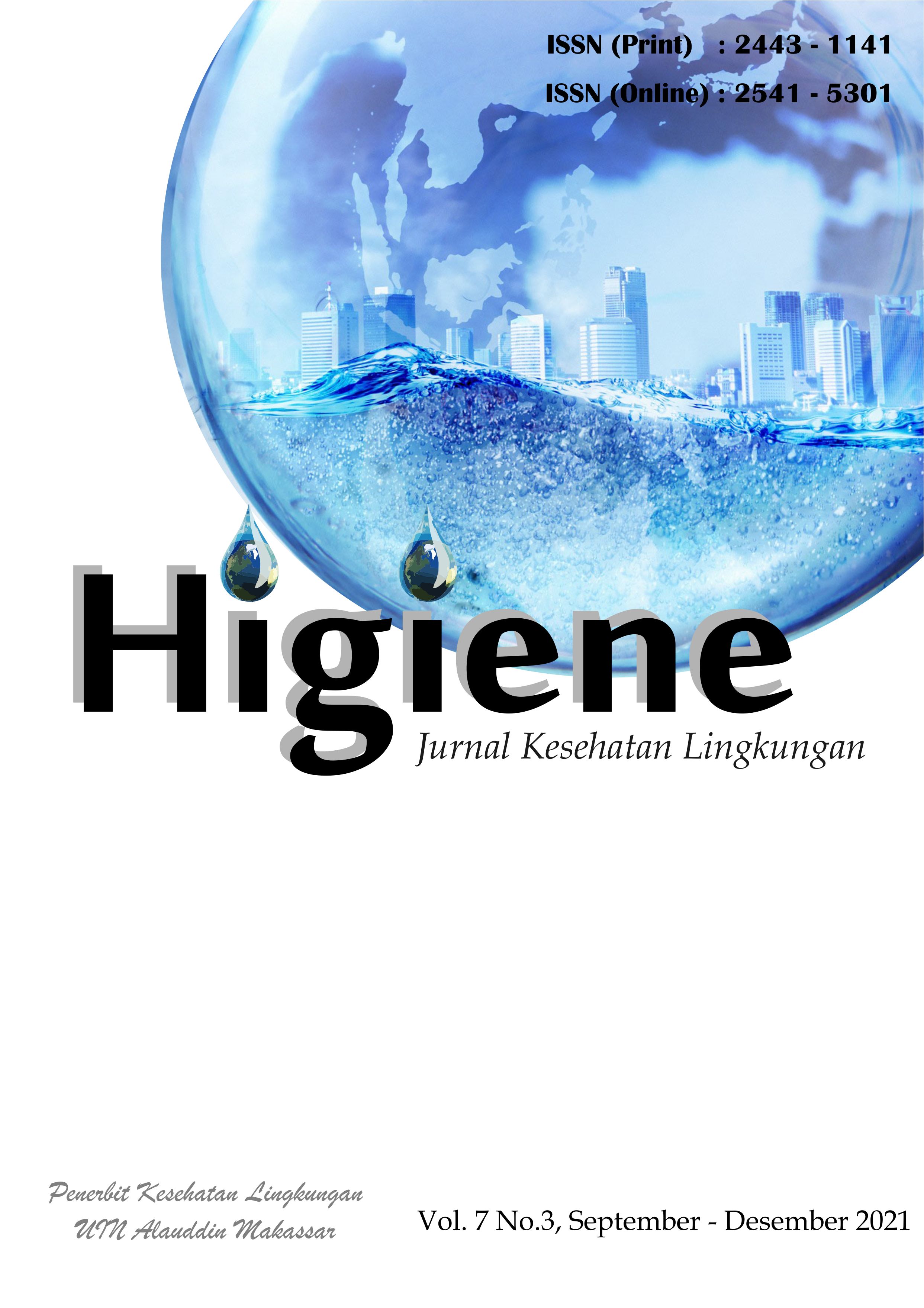Aedes Sp. Larvae Density Related to DHF Incidence in Tamalate District of Makassar City
Abstrak
Dengue Hemorrhagic Fever (DHF) is a disease that is transmitted by the Aedes sp. In 2019 there were 138,127 cases with 919 deaths. One of the factors that influence the increase or decrease in the incidence of Dengue Hemorrhagic Fever (DHF) is the population of Aedes aegypti mosquito larvae. The purpose of this study was to measure the density of Aedes sp. related to the incidence of DHF in Tamalate District, Makassar City. This research is a descriptive type of research, with a visual survey method. The research sample is the number of cases in 2017 which is as many as 20 samples with the inclusion criteria of mosquito flight distance to meet the number of 100 samples. The results of the study of 100 houses inspected in Tamalate District there were 28 houses that were positive for larvae, thus obtaining a House Index (HI) value of 28%, and included in the medium density category, from 524 containers inspected in Tamalate District there were 44 positive containers. larvae were found, thus obtaining a Container Index (CI) value of 8.3%, included in the medium density category, there were 44 positive larval container containers from 100 houses inspected in Tamalate District, thus obtaining a Breteau Index (BI) value of 44% and included in the category medium density level, for the Density Figure category the House Index (HI) value of 28 so that the results of Density Figure (DF) 4 are included in the Density Figure (DF) category of medium density, the result of Container Index (CI) 8.3 so that the results of Density Figure ( DF) 3 is included in the Density Figure (DF) category of medium density, and the results of the Breteau Index (BI) 44 so that m get the results Density Figure (DF) 5 is included in the Density Figure (DF) category of medium density. Researchers suggest to the public to carry out PSN activities continuously with the 3M Plus method.
Referensi
Dinas Kesehatan, K. M. (2018). Jumlah Kasus DBD. Makassar: Dinas Kesehatan.
Dinas Kesehatan, K. M. (2021). Jumlah Kasus DBD. Makassar: Dinas Kesehatan.
Kementerian Kesehatan, R. (2017). Pedoman Pencegahan dan Pengendalian Demam Berdarah Dengue di Indonesia. Jakarta: Kementerian Kesehatan RI.
Kementerian Kesehatan, R. (2019). Profil Kesehatan Indonesia. Jakarta: Pusat Data dan Informasi Kementerian Kesehatan RI.
Kementerian Kesehatan, R. (2020). Profil Kesehatan Indonesia. Jakarta: Kementerian Kesehatan.
Kementerian Kesehatan, R. (2016). Situasi DBD di Indonesia. Jakarta Selatan: Kementerian Kesehatan.
Khotafiatun. (2021). Survei Kepadatan Jentik Nyamuk Aedes Aegypti Pada Penampungan Air Dalam Rumah Dan Implikasinya Terhadap Keperawatan Komunitas. Jurnal Keperawatan Komprehensif Vol. 7 No.1, Januari 2021 , 74-79.
Kurnia, R. (2021). Indeks Entomologi Vektor Nyamuk Aedes sp. di Daerah Endemis Demam Berdarah Dengue di Kecamatan Tanjung Pinang Timur Kota Tanjung Pinang Provinsi Kepulauan Riau. Jurnal Kesehatan Terpadu , 1-7.
Lestari, B. (2020). Upaya 3M Plus terhadap Kepadatan Jentik Aedes sp. dan Kejadian Demam Berdarah Dengue di Indonesia. Jurnal Kesehatan Masyarakat , 1-22.
Linawati Alim, F. H. (2017). Tingkat Kepadatan Jentik Nyamuk Aedes aegypti pada Tempat Penampungan Air Controllable sites dan Disposable sites di Sekolah Dasar Kecamatan Banjarbaru Utara. Berkala Kedokteran , 8.
Menteri Kesehatan, R. (2017). Peraturan Menteri Kesehatan RI : Standar Baku Mutu Kesehatan Lingkungan dan Persyaratan Kesehatan untuk Vektor dan Binatang Pembawa Penyakit Serta Pengendaliannya. Jakarta: Menteri Kesehatan.
Nurdiansa Sahrir, H. I. (2016). Pemetaan Karakteristik Lingkungan dan Densitas Nyamuk Aedes aegypty Berdasarkan Status Endemisitas DBD di Kecamatan Kolaka. JST Kesehatan , 70-71.
Profil Kesehatan Prov. Sul-Sel. (2016). Jumlah Kasus DBD. Makassar: Dinas Kesehatan Kota Makassar.
Sumantri, A. (2017). Kesehatan Lingkungan. Depok: Kencana.
##submission.copyrightStatement##
##submission.license.cc.by4.footer##Informasi Hak Cipta
KEBIJAKAN HIGIENE : JURNAL KESEHATAN LINGKUNGAN (AKSES TERBUKA)
Syarat yang harus dipenuhi oleh Penulis sebagai berikut:
- Penulis menyimpan hak cipta dan memberikan jurnal hak penerbitan pertama naskah secara simultan dengan lisensi di bawah Creative Commons Attribution License yang mengizinkan orang lain untuk berbagi pekerjaan dengan sebuah pernyataan kepenulisan pekerjaan dan penerbitan awal di jurnal ini.
- Penulis bisa memasukkan ke dalam penyusunan kontraktual tambahan terpisah untuk distribusi non ekslusif versi kaya terbitan jurnal (contoh: mempostingnya ke repositori institusional atau menerbitkannya dalam sebuah buku), dengan pengakuan penerbitan awalnya di jurnal ini.
- Penulis diizinkan dan didorong untuk mem-posting karya mereka online (contoh: di repositori institusional atau di website mereka) sebelum dan selama proses penyerahan, karena dapat mengarahkan ke pertukaran produktif, seperti halnya sitiran yang lebih awal dan lebih hebat dari karya yang diterbitkan. (Lihat Efek Akses Terbuka).

